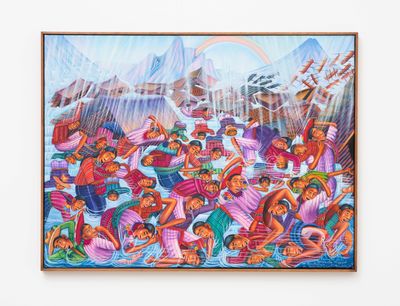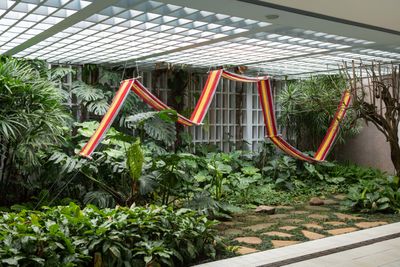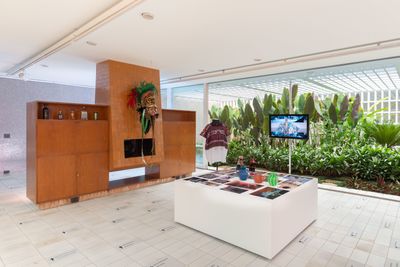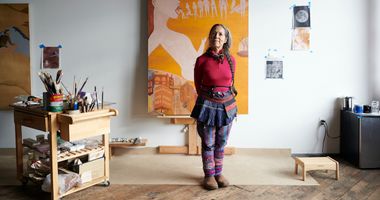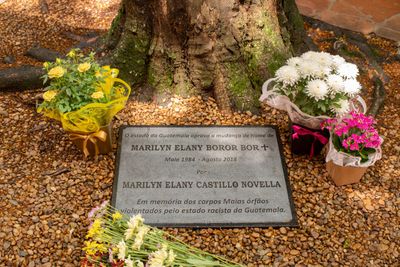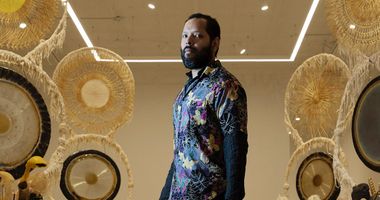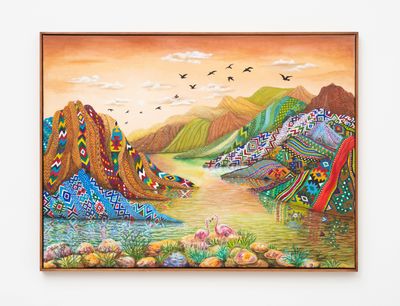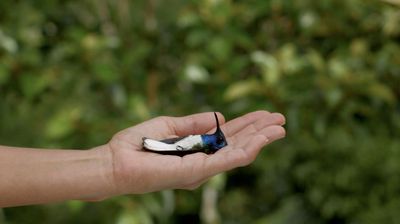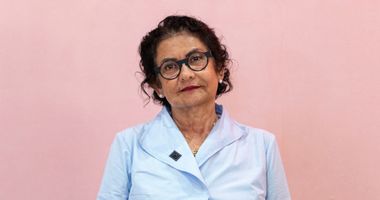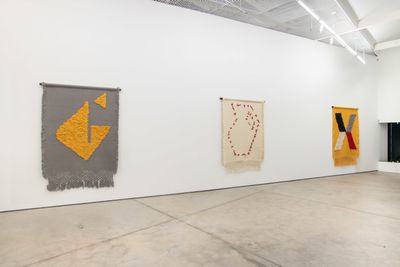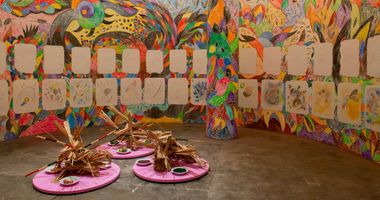In Praise of Birdsong: Silent Spring in São Paulo

Exhibition view: Primavera Silenciosa, Luciana Brito Galeria, São Paulo (7 October–20 December 2023). Courtesy Luciana Brito Galeria. Photo: © Edouard Fraipont.
In her 1962 book Silent Spring, American scientist Rachel Carson describes a polluted future environment where birds no longer sing. Departing from this title, a group exhibition Primavera Silenciosa [Silent Spring] at Luciana Brito Galeria in São Paulo focuses on the critical state of disregard for the environment and Indigenous peoples in favour of capitalist advancements.
In Primavera Silenciosa (7 October–20 December 2023), works by 16 artists from Brazil, Guatemala, Honduras, Mexico, Chile, and Panama are brought together by Chilean curator Alexia Tala, whose expertise in Latin American art was reflected in her experience as chief curator of the 22nd Bienal de Arte Paiz in Guatemala (2021).
At Luciana Brito Galeria, site-specific installations, photography, videos, tapestries, and paintings are organised according to three conceptual axes: the appropriation and erasure of Indigenous cultures in Central and Latin America; the interconnection of natural ecosystems and humankind; and the intrinsic relationship between capitalism and the exploitation of natural resources.
Luciana Brito Galeria occupies the restored Castor Delgado Perez heritage residence, a 1958 modernist building that was designed by Brazilian architect Rino Levi, with landscape design by Roberto Burle Marx. The main exhibition space was originally an open-plan living room—where the original fireplace remains—and is flanked by two tropical conservatories.
This space pops with colour. Catching the eye upon entering are the bright shades of Kukulkan (2023), a yarn installation by Guatemalan artist Antonio Pichillá. The long, serpentine tapestry is suspended at intervals from the ceiling of one of the conservatories, where its yellow, red, and pale blue-grey tones contrast against the deep greens of the foliage below. Sections of the lengths of yarn are held taut by wooden sticks, referencing traditional weaving looms, and parts are anchored to the ground by individual wool strands tied to rocks.
Named for the homonymous Mayan feathered serpent deity, Pichillá's Kukulkan takes its form from a depiction of the deity in a sacred Mayan codex that is most commonly known today as the Madrid Codex because of its appropriation by the Spanish. Its installation within the conservatory speaks to the deity's traditional habitat and care for natural environments.
Opposite Kukulkan in the interior space, Colección Poyón (2014–2023) by Guatemalan brothers Ángel and Fernando Poyón critiques the capitalist exploitation and trivialising of traditional cultural artefacts. The work comprises a collection of photographs, found objects, and videos that make use of Mayan symbols, imagery, and crafts. These include coloured plastic mementos in the shape of traditional pottery vessels, images of adverts, homes and public spaces that make use of replicas of stone sculptures as décor. The collection also holds a Bible translated into Mayan languages used by missionaries.
Hanging above the fireplace is a mannequin head in a large feather and foliage headdress, while in front of it, an erected bust is dressed in a synthetic textile tunic digitally printed with what resembles a traditional Guatemalan embroidery pattern. On an adjacent TV screen, a video shows Miss Guatemala at a pageant wearing a similar headdress to that seen above the fireplace, and a cape depicting images of the Mayan codex that is now held in Dresden, Germany.
Colección Poyón captures multiple facets of cultural displacement. Fetishised appropriation and the performative heralding of traditional objects become gestures that empty artefacts of their intended significance and function, reducing them to banal souvenirs of capital.
Guatemala-based Maya Kakchiquel artist Marilyn Boror Bor also explores the role of language in contributing to the loss of cultural meaning and identity. For Edicto Cambio de Nombre (2018), Boror Bor researched the exchange of peoples' Indigenous given names to European ones, a change likely stimulated by the desire to dodge social stigma and prejudice. Tiles on the floor of the main exhibition space, inscribed with original names, establish a metaphorical burial ground for the Mayan identities that were erased by discrimination.
For this project, Boror Bor's own legal name change to Marilyn Elany Castillo Novela is recorded on a metal plaque under a tree in the back garden, surrounded by fresh cut flowers. 'Castillo Novela' is adopted from the family who own Guatemala cement factories that devastated the industry of growing flowers for export that was the subsistence for Boror Bor's people in San Juan Sacatepéquez.
Guatemalan painters Diego Isaías Hernández and Paula Nicho also tap into their local cultures and surroundings, as well as their dreams and memories. In the corridor that connects the front block of the house to the back rooms, colourful medium-scale landscapes in oils are painted in the style of Guatemalan popular paintings.
Hernández shows apocalyptic images of natural disasters he remembers, such as the devastating 1976 earthquake in Guatemala and the 2022 Hurricane Agatha. Nicho portrays dreams of herself flying, clad in traditional dress, above a bountiful seascape in Mi Sueño (2023) and a valley of mountains draped in traditional fabrics in Dulce compañía (2023).
The role of dreams is also explored in the video-performance Kawoq (2023) by the duo Tz'aqaat (Cheen Cortéz and Manuel Chavajay). Cortéz stands knee-high in Lake Atitlán, Guatemala, and speaks into a clay pot found in the lake to the goddess of weavers she has dreamt of emerging from the water since childhood.
As Tala describes in her exhibition essay, the term 'cosmovisions' reflects the indigenous worldview that humans and the natural environment are interconnected in a non-hierarchical way. Alongside Coletivo Tz'aqaat's video, this concept is embodied in two large, mixed-media paintings by Manuel Chavajay. Embroidered with numerous spheres, Chavajay's works depict his experience of the movements of the moon in the landscape his studio is in.
Sharing the spirit of registering personal experiences with nature is Brazilian artist Rochelle Costi, whose videos of insects she cohabited with in her home during the Covid-19 pandemic are exhibited on loop with videos by other artists in the gallery's underground bar area.
Presented in the gallery's annexe is Panama artist Donna Conlon's spellbinding video From the Ashes (2019), which offers a glimpse into nature's power of regeneration. At first it is unclear what the shimmering blues and greens are on the TV screen, which is revealed to be a hummingbird. At one point there is the blink of the bird's eye, just before the shot pans to see it flying away, in slow motion, from the human hand that cradled it.
On the wall opposite Conlon's video are three large-scale tapestries by Antonio Pichillá: Air, Water, and Fire, (all 2023). Each shows a geometric symbol that represents natural elements that are sacred to Pichillá's community. A tree root draped in wool yarn, representing earth, is placed in the middle of the room.
The Capitalocene era, a timescale described by Swedish environmental activist Andreas Malm as 'the geological epoch not of humanity, but of capital,'1 is referenced by Tala in her curatorial text. A resulting feature of this era is excess, which in turn leads to an overabundance of rubbish. Conlon and Jonathan Harker denounce this in their video Estación Seca (2006), in which a massive pile of green glass bottles—resembling a bucolic landscape with rolling hills—is added to, with new bottles thrown onto the pile and breaking.
Honduran artist Adán Vallecillo uses discarded food remains to create natural pigments, with each tone displayed on individual paper swatches for Pintura Mural, São Paulo (2023). These are installed in a grid formation, with two larger swatches painted directly onto the wall. With these swatches, the artist not only demonstrates the volume and variety of rubbish he came across, but also that what is deemed rubbish by some can be regenerated and reused by others.
Primavera Silenciosa proposes a platform for revealing existing relationships between humans, nature, and spiritual experiences that may be overlooked in the era of capitalism. Amongst the many feelings and learnings one can come away with, is the question of why capitalist interests continue to thrive, and people contribute to shaping a world in which birdsong can no longer be heard? —[O]

